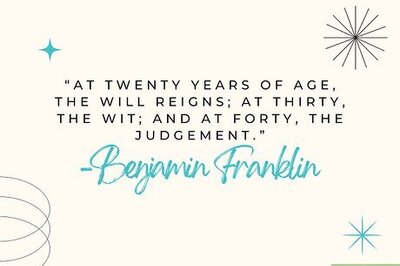
views
Lingering mystery in the romance of silence, awakens joy in the canvas of poetry. And, in the simplistic dictum of art, thrives the most passionate mode of individualism.As Alfred North Whitehead said, “Art is the imposing of a pattern on experience, and our aesthetic enjoyment is recognition of the pattern.” Portraying intense emotions with contrasting textures and vivid colours; Pavithra Devadatta has beautifully captured the purity of spirit in paintings with her latest art show Kalanz at Leela Galleria.The early influence of growing up in a literary, musical and artistic joint family has taken form, shape and an unmistakable vibrancy of colour and movement in her work. City Express catches up with the extraordinary artist to find out more about capturing music in colour and delving into unexplored territories with art.What is it about art that intrigues you the most? The whole world of art stimulates different parts of me; whether I am painting or watching others paint or viewing paintings anywhere in the world, I feel a trigger in me. And, that stimulation is addictive. It starts making connections and I am making connections beyond it. It’s a world without barriers. It is scary, it is enticing.How difficult is to capture realism in paintings? I am against realism, the kind you make with photos.To be honest, I have not even attempted it. Painting is from the inside. To me, reality is a musician lost in his music, not how he looks while making music.You drew inspiration from public performers at jazz and tango festivals.Tell us more...Yes, I drew inspiration from both. The jazz festivals are public roadside performances by people who are good with their music. They are so into it that they can forget time, place, people walking about and everything.They have the courage to be lost in their music, to be one with it and apart from the bustling activity around them. They have a particular look of being somewhere else while being here.They have reached a purity of spirit that frees them to enjoy making their music even in a public space. It’s the contrast of being there and yet not being there.That’s the contrast I want to capture.In the tango series, the contradiction is in two people moving as one, sending signals to each other as if they are one. Both are in sync because of their passion for the dance form.From the moves, they draw an energy that makes them one. These festivals are during the Easter week in Tauranga and October in Wellington.How would you primarily differentiate between the textures of water and oil-based colours? That depends on how adventurous I feel. Water colour is hard to predict. It takes on a life of its own and I will have to go with the flow, making decisions on the fly and not be tied down to theme and mood. That’s its beauty.That’s also its challenge.You have to let it do its own things and you have to stop when it tells you to; you can’t over-work it. If you have been listening to it, you’ll get a good painting.You can’t predict the final result. It’s the letting go that I love about it. Oils are more about being in command though even there you are in control only to transfer something else on to the canvas without interpreting it.Some of your paintings portray intense emotions. How did you manage to achieve such depth in both details and sentiments? I come from a music and colour family. I remember standing under my father’s violin as he played, letting the music flow through me.I remember him making music with his friends in our house.I remember the smell of linseed and the clutter of handmade paper in our drawing room and my father painting in a frenzy. I remember going every year to the Lalitha Kala exhibitions at the Institute of Engineers to see his paintings exhibited there.I have images of the vibrant colour combinations of my mother’s sarees; she always wears traditional colours and weaves, both cotton and silk.So I guess it was a way of my heritage coming alive in me as feelings long before I was aware of it.What are your thoughts on impressionism? Impressionism is a great discovery of opposites giving life to each other, of contrasting colours in the colour-wheel giving luminosity. For instance, red gets luminous when contrasted with green, which it doesn’t get when it’s on its own or when it’s with any other colour.These two are partners that manifest the uniqueness in each other. That’s the crux of the discovery, like a marriage of compatibles. They share a wavelength. They vibrate with each other.Busker series not only added life to the canvas but also captured music in colour. Tell us about your journey with this series.There was no journey. As I said earlier, I was in it long before I was aware of it. The jazz festivals just triggered a connection with what I have inherited. I didn’t have to learn anything; it’s from every day, like arshna-kumkuma and the white and rust of rangoli.How important is it for artists to break traditional norms and delve into unexplored territories with art? It’s the hallmark of art to break free. You have to unleash yourself to get into yourself, to reach within yourself. It’s the act of breaking any rule to find your self and to bring it out. Art is what you make of it, like anything else.As an artist what do you strive to achieve with your work? I’d like my art to touch the spirit of my viewers in some way. One of my friends told me she had seen someone dying in a hospital and was weighed down by the intense tragedy of the whole situation.That’s when she went to this exhibition of my paintings at the Leela Galleria. She said she felt her spirit being lifted as she viewed them.















Comments
0 comment